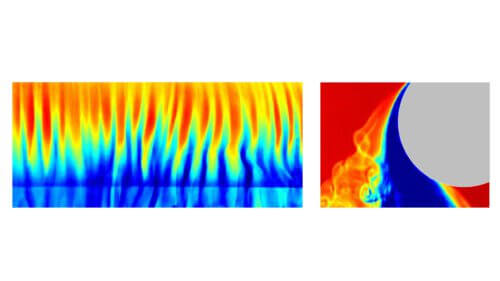More than two hundred years after the discovery of the Koanda effect: researchers at the Technion present the first experimental observation of tiny tornadoes in an air current. To discover significant applications in ventilators, microflow devices and tiny aircraft

Technion researchers present the first experimental observation of instability in the Coanda effect - an important physical phenomenon associated with jet streams - and new discoveries about the behavior of these jets. The researchers, PhD student Lev Dunayevich and Prof. David Greenblatt from the Faculty of Mechanical Engineering, present the achievement in a featured article in the journal Physics of fluids. According to them, since the phenomenon is related to air flow, the research may help in the improvement of ventilators such as those required in the treatment of COVID-19 patients as well as in many other fields including tiny aircraft, tiny devices for mixing liquids and systems for cooling electronic components.
The Coandă effect, named after the Romanian inventor Henri Coandă, manifests itself when a jet moving near a convex surface curves around the surface instead of moving in a straight line. If, for example, air flows near a ball, the air will tend to stick to the ball and move around its circumference up to a certain point. Although the aforementioned effect was studied in flows already at the beginning of the 19th century, Kuanda was the first to apply it in an aerodynamic context about a century ago.
Another important effect in jets, discovered more than a century ago by the British physicist Lord Rayleigh, is centrifugal instability. The meaning of this term is that certain jets develop Tiny tornadoes (mini-tornadoes) whose funnels face forward in the direction of the advance of the jet. In the XNUMXs, the theoretical conditions for the existence of the phenomenon were defined, but the effect has not yet been observed experimentally.
All this has now changed with the research of Dunajevich and Prof. Greenblatt. By launching a flat jet over a cylindrical body, the two were able to map those tiny tornadoes for the first time. In the current article they present the necessary conditions required for the existence of these storms, conditions that are in line with the theory, and also show how those storms lose shape and disintegrate. This process of tiny tornadoes forming and dissipating has dramatic implications for location the disconnection point of the jet from the surface.
According to Prof. Greenblatt, "The discovery of the centrifugal instability surprised us a lot, and we estimate that it also exists in the blood flow in the body and the air flow in the ventilators. For many years, it has been believed that the Koanda effect is the reason why the ventilators do not circulate the air to the lungs uniformly - a process that causes harm to the patients - and I estimate that our discovery will help improve these machines for the benefit of corona patients and other patients."
Now, with the support of the National Science Foundation (ISF), Dunajevich and Prof. Greenblatt are investigating possible ways to control the mini-tornadoes in a way that harnesses the Coanda effect for the improvement of various medical devices and industrial applications.
For an article in the journal Physics of Fluids click here

2 תגובות
There is a Spanish startup that is developing a special turbine to create electricity from an effect related to this - https://vortexbladeless.com/technology-design/
This is Mandelblit's nod